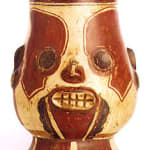Vessel Depicting the Head of Tlaloc, 1000 CE - 1550 CE
Terracotta
12.5
PF.4494
One of the most intriguing mysteries of art is why a particular style, which may have lasted for hundreds of years, suddenly changes into something totally different. Changes in population,...
One of the most intriguing mysteries of art is why a particular style, which may have lasted for hundreds of years, suddenly changes into something totally different. Changes in population, political upheaval, religion, or just simply a spark of genius from an anonymous artist are enough to alter the course of an artistic trend. Between 1150 and 1250 A.D. the Costa Rican artists developed a style of pottery with patterns in black and red on a white background, known as Pataky. Though the form of each vessel may vary, there is uniformity in the distinctive chimney-like upper portion. Another unusual and fascinating feature are faces molded and painted in an amazing array of style, but with certain important similarities; such as a mask-like appearance, grinning expression and ear spools. This remarkable vessel shows two faces; one in relief and the other painted. The main figure, as it appears to be, has a stylized mouth formed in a grimace, its eyes are black circles opened wide and expressive, and highlighted by red sections around the eyes and chin. The face on the back has a broad smile and whimsical expression, with a series of semi-circles underneath which give it volume and depth. The rounded eyes of the frontal face may represent the Mesoamerican rain god; or it may represent a mask worn in ceremonies. This vessel was probably part of funerary furniture and designed for symbolic reasons rather than an utilitarian function. Whatever its exact purpose, we can thoroughly enjoy the range of emotions this vessel creates, and let our mind wander back to a time where rituals of magic and mystery were embodied in extraordinary art.



